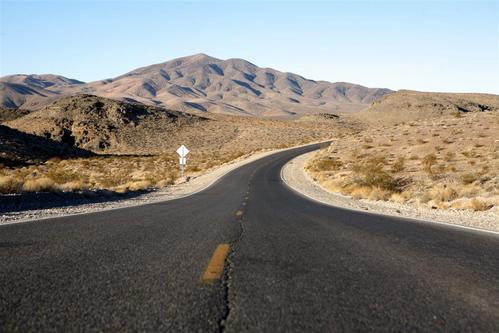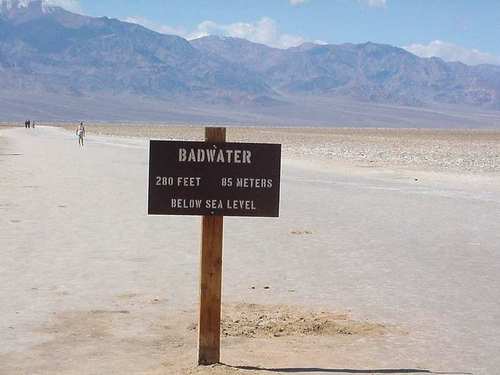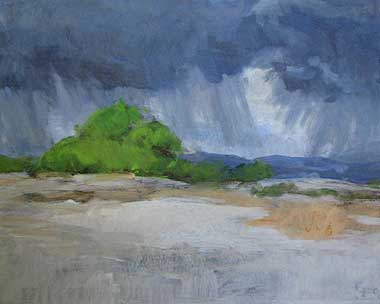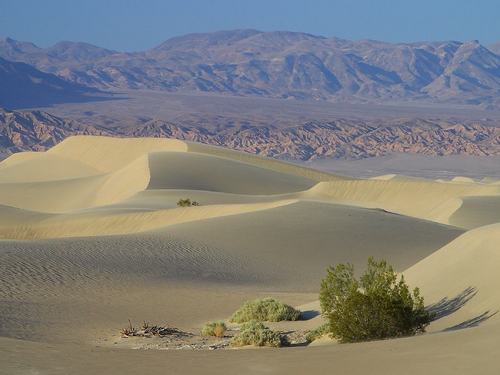I enjoyed reading this since we worked and lived in Death Valley in 1980. I added the photos for you to see the beauty and hope you will enjoy this as much as I did. Ana
A Poet in Death Valley
Remembering Miroslav Holub.
| Death Valley the Furnace Creek Visitor Center & Museum. |
In the
afternoon, after a stop at the Furnace Creek Visitor Center to pose a
few questions about the locals—Holub’s deadpan reference to the lizard
population—we drove through the dry vastness of the Valley, the vault
of blue above.

“What do you think about angels, Miroslav?” I asked. “Do you believe in some kind of spiritual creature?”I imagined the plentiful side-blotched lizards listening in.“Angels, they are present in the poems. But,” he said, “they are not required to save anyone.” “And the ‘so-called’ soul?” I asked, as I’d heard him phrase
it. Though the two entities existed hand-in-glove in my upbringing, I
could hear in Miroslav’s pause that we’d made a distinct turn of
subject. Yes, the soul, too, was present, at times connected to painful
situations.
In “Crush Syndrome,” as translated by David Young and Dana
Hábová, the soul is connected to the body but is not of the body. After
the speaker’s hand is crushed, he recognizes that he indeed has a soul,
that it’s “soft, with red stripes, / and it want[s] to be wrapped in
gauze.” The soul is attended to at the clinic, grasping with its
“mandibles” and then appearing as a being of “whitish crystal” with a
“grasshopper’s head.” By poem’s end, the soul rests as a “scar,
scarcely visible.” Here, as in other of his poems and essays written
over four decades, the soul has its own desires and abilities.
Similarly, at the close of “Creative Writing,” composed in Holub’s last
year, and as we translated it, the aging woman who aspires to
permanence possesses a “fluid soul.” In Holub’s cosmic verse, the
individual soul is a changeable entity, unpredictable and as vulnerable
to experience as its host.
* * *
I’d flown into Ontario, California, the closest airport to
where Holub was a writer in residence for a semester at Pitzer College
in 1985. A former student, friend, and
sometimes translator, I’d come to visit the Czech immunologist and
poet. But when I arrived, he wasn’t there at the gate to greet me. So I
waited. Nearly two hours later, he rushed in.
“Why are you still here?” he half demanded, half apologized. I told him I’d decided to wait, in case something had happened. If he didn’t show, I’d take a taxi to his house. He nodded in approval; then his mouth grew tight. “My Gott.
I messed it up. Sorry.” The “my” was elongated, “sorry” was clipped.
“Messed” received the greatest emphasis. For one who caused a mistake,
including himself, Holub had little patience. He had gone to the wrong
airport. We walked to the rental car.
During that April week in Southern California we logged two
thousand miles: from Venice Beach with its roving hucksters and
rollerbladers in short-shorts to Joshua Tree National Forest and its
yucca, its fire-topped ocotillo, and views of the San Andreas Fault.
Back in Claremont midweek, Holub taught his poetry seminar and I sat
in, jotting down many of his pithy observations: “the adjective is not
key; it’s simply an ornament.” And, “a poetry book is not a bag
containing poems, just like the body is not a bag containing bones. The
book has a structure. You must be aware of it.”
I was assembling my own collection, and Holub carved out time
to comment on my ripening poems: too much description here. You’ve
avoided overstatement at least. What’s your point? Indeed, as poets,
our own work was radically different. As Holub characterized our styles
in those days: “I want poetry to be a knife; yours is a caress.”
: www.davidyoungpoet.com/page9a.html
I can see Miroslav that first Sunday in the Valley—and this
fading photograph in my hand helps me to do this—looking pleased and
vigorous in his sage-colored, button-down shirt, neatly tucked into
PermaCrease slacks. Behind him, afternoon shadows cover the scrubby
hills partway while clouds gather on the horizon. He’d been many places
in the world, and still he had revolutions and revisions of the map
before him. Earlier that weekend in Death Valley, his interest lay with
the algae and invertebrates that inhabited the Badwater Pond and had
adapted to the extremes of temperature and saline. Surrounded by miles
of crusty salt flats, we craned our necks at the SEA LEVEL sign high in the rocky cliffs. For those few moments, as we perspired
in the heat and fought the sun’s glare, we considered our world from -282 feet.
Did he know of the Death Valley spadefoot toads—not true
toads, he would have ferreted out—that wait underground in a dehydrated
state for months, popping up after sufficient rain and bleating like
sheep? The “real deep surprises,” he’d offered, “come in the sciences.”
In the mid-sixties, as part of a collective project, Holub discovered
that the lymphocyte is the key cell of the entire immune system. The
path to that discovery was forged by something beyond the working
hypothesis, exacting methods, and repeatability of the results. It
included, as he recounts in his essay “The Discovery: An Autopsy,” as
translated by David Young and Catarina Vocadlova, a feel for his
material—“the lymphocyte, with its ability to transform itself, and
with its limitations.”
Many years later, when I returned to Death Valley I thought of
Holub in the last years of his life, as travel became increasingly
difficult for him because of a degenerative hip condition and
unpredictable bleeding from the eye. Receiving awards and giving
readings, he pressed on, to Pescara and Wellington and Hong Kong and
beyond, his urge to ask, to see: unquenchable.
As I stared across a
wooden borax wagon at the sweep of the land, the cool wind picked up. A
sudden, barely discernable moisture was present in the air. A few
people scurried toward their trucks and suvs. I scanned the sky. There it was, a rose-gray moving mass—verga, the rain that is visible above but never touches the earth.
the rain that is visible above but never touches the earth.
Death Valley Photoshttps://www.pdphoto.org/index.php.
Miroslav Holub in Death Valley Photo by Rebekah Bloyd
verga frux.net/deathvalley06.html
Miroslav Holub poetryandpoetsinrags.blogspot.com/2007_07_01_.
https://www.poetryfoundation.org/journal/article.html?id=237074
excerpt
Writing
about the future
Talk
given to the fourth Freelance Journalists, Artists and Photographers
conference of the Media, Entertainment and Arts Alliance, Sydney,
April 28, 2001
https://www.metafuture.org/articlesbycolleagues/rosaleenlove/writingthefuture.htm
"Conscious
evolution is where
biological evolution meets cosmic evolution.
Some
Humanity 3000 participants were enthusiasts for a cosmic spirituality in which a feeling for the universe is the
key to both personal and planetary salvation.
Some
participants went straight to the an event roughly four billion years
from now, when the planet earth comes to an end, swallowed up by the
sun as it flares up in the last stage of its existence. They saw it as
a human imperative to leave earth, well before it dies, to venture
forth into the solar system and beyond to keep life of some kind
keeping on. They see humans co-evolving with the universe, and with
machines, in order to accomplish this tremendous task.
More
realistically, just sticking to our own planet, I like what the
Czech immunologist and poet, Miroslav Holub (1923-1998) had to say.
Holub saw himself as a
unit of something bigger,
which he called ‘genome’ rather than ‘spirit’. His individual genome was the sum total of all the genes in his
body, yet also shared in the genetic process of all life. Holub saw
his life as a continuous part of an evolutionary whole which stretched
from the past history of life on earth into its future. He placed
himself before the genome in a spirit of humility; ‘we are not the
aim of the process’.
In
his poem, ‘The root of the matter’, Holub wrotes: ‘the root of
the matter is not/in the matter itself and often/not/in our hands.’ Where is the darkness, he asks? Where is the uncertainty? The
scientist, in the spirit of humility, is asking what the individual
can do in a world where nothing is one hundred percent sure.
Holub
imagined a kind of biological or genetic supraconsciousness, where the
biologist finds meaning in life by accepting responsibility for the planet
as a whole, and as a viable system. The
immunologist plays a part in this process of stewardship through seeking
to control the disease process in plants, humans, and other animals. In
talking about a genetic supraconsciousness, Holub goes way beyond the
‘here and now’ of present biological knowledge, but does so in a
spirit of humility before human ignorance of the whole. I
like his vision."
When the bees fell silent by Miroslav Holub
An old man suddenly died
alone in his garden under an elderberry bush.
He lay there til dark, when the bees
fell silent.
A lovely way to die, wasn't it,
doctor, says the woman in black
who comes to the garden
as before, every Saturday,
in her bag always lunch for two.
trans. by Ewald Osers
POET
Miroslav Holub (1923 - 1998)
excerpt
Miroslav Holub is a scientist by vocation and considers his poetry a pastime. Holub told Stephen Stepanchev in a New Leader interview that the Czech Writers Union had offered him a stipend
equivalent to his salary as a research scientist to enable him to
devote two years to his poetry. "But I like science," he said. "Anyway,
I'm afraid that, if I had all the time in the world to write my poems,
I would write nothing at all."
Holub read his poems in 1965 at the Spoleto Festival, Italy, in 1967 at
the YMHA Poetry Center in New York under the auspices of the Lincoln
Center Festival, in 1968 at the Harrogate Festival, England, in 1974 at
Poetry International, Rotterdam, Holland, in 1975 at the Cambridge
Poetry Festival, Cambridge, England, and in 1981 at the International
Poetry Festival, Toronto, Ontario, Canada. Holub spoke English,
French, and German.
https://www.poetryfoundation.org/archive/poet.html?id=3240




